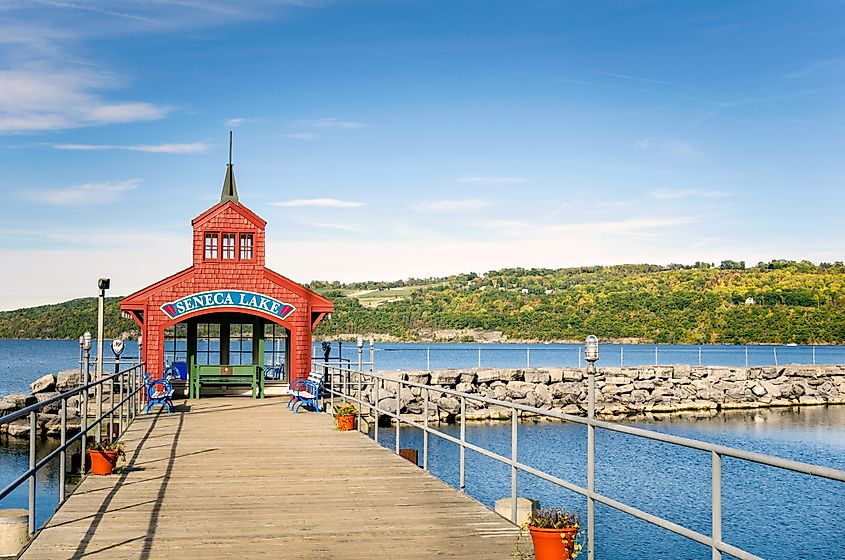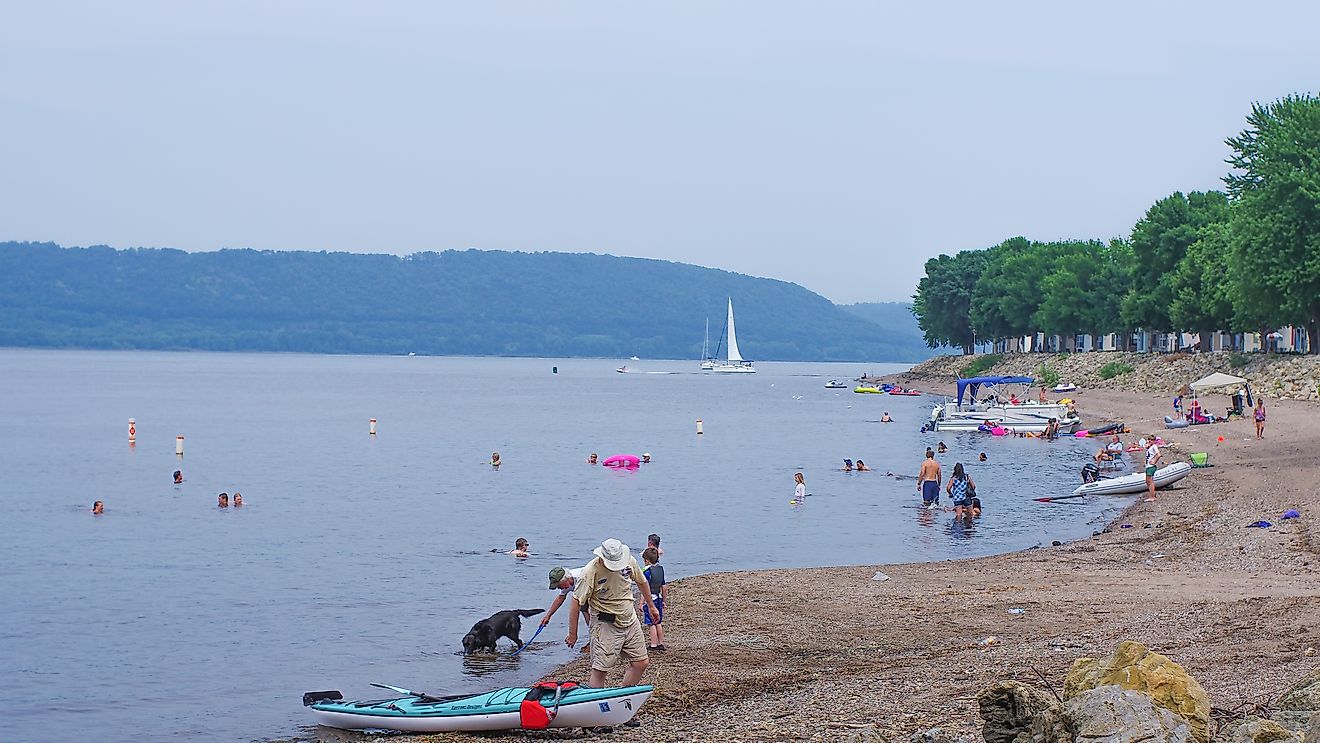
Finger Lakes
There is everything to gain and nothing to lose when it comes to 9,000 square miles of virtually untouched American wilderness. The Finger Lake region has taken its name from the appearance of its 11 bodies of water, which are long and slender and finger-like from a bird's-eye-view. Moreover, many of the lakes are protected by law, completely preventing any form of development. The few towns which have managed to settle nearby are hearty places that focus on agriculture (specifically wine), tourism, recreation, and even world-class education and research. Ultimately, the best way to learn about these lakes, besides reading about them here, is to visit them.
Keuka Lake

Keuka Lake is a distinctive Y-shaped body of water measuring approximately 20 miles long and 2 miles at its widest point. It is the third largest of the Finger Lakes and unique for its two branches that connect at Bluff Point.
The formation of Keuka Lake dates back to the Pleistocene Epoch, around 2.6 million years ago. The lake was carved by retreating glaciers, leaving behind a deep water-filled basin. The name "Keuka" is derived from the Iroquois word "Ke-U-Ga," which translates to "lake with an elbow." Early settlements around the lake began in the late 18th century, with European settlers establishing roots in the region. The development of the Crooked Lake Canal in 1833 connected Keuka Lake to the Erie Canal system, spurring economic growth.
The climate around Keuka Lake can be classified as humid continental, characterized by warm summers and cold winters. Furthermore, Keuka Lake has no natural islands within its boundaries. However, there are some artificial islets, such as marinas and boat docks.
Several towns and villages are located around the shores of Keuka Lake, including Penn Yan, Hammondsport, Branchport, and Pulteney. The primary industries in the region include agriculture, tourism, and wine production. The fertile soil and favorable climate make the area well-suited for growing a variety of crops, particularly grapes. Furthermore, the lake's setting attracts tourists who engage in recreational activities such as boating, fishing, and hiking. In essence, Keuka Lake is a significant contributor to the Finger Lakes wine region, which is home to numerous vineyards and wineries that produce high-quality wines, particularly Riesling and Chardonnay.
Canadice Lake

Not all Finger Lakes are equal (in size); Canadice Lake is on the smaller side, measuring approximately 3 miles long and 0.3 miles wide alongside a maximum depth of 95 feet. Despite its size, Canadice Lake plays an essential role for nearby residents as a source of drinking water.
The formation of Canadice Lake, like the other Finger Lakes, is attributed to glacial activity during the last ice age, which created deep valleys that subsequently filled with water. The region was originally inhabited by Native American tribes, including the Seneca people, who were part of the Iroquois Confederacy. European settlers arrived in the 18th and 19th centuries, leading to the development of towns and communities in the surrounding areas.
The climate surrounding Canadice Lake is characterized by warm summers and cold winters, consistent with the broader Finger Lakes region. The lake has a moderating effect on the local climate, contributing to a longer growing season that supports the agricultural sector. The microclimate around the lake is suitable for the cultivation of grapes, apples, and other fruit crops, although the area is not as well-known for wine production as some of the larger Finger Lakes.
Due to the lake's importance as a source of drinking water, the surrounding shoreline is largely undeveloped, and there are no towns or communities situated directly along its shores. However, the nearby towns of Hemlock and Honeoye are in the vicinity of Canadice Lake. Canadice Lake, like every Finger Lake, is a popular destination for recreational activities, such as kayaking, canoeing, and fishing. Ultimately, for those trying to escape into the calm of unbothered nature, Canadice Lake offers the perfect respite.
Canandaigua Lake

Historically, the area around Canandaigua Lake was similarly inhabited by the Seneca tribe until displacement was caused by various settlers from Europe. The lake itself measures 16 miles long and 1.5 miles wide, with a maximum depth of 276 feet. Once again, this lake experiences warm summers and cold winters which benefit agricultural industries.
Although Canandaigua Lake does not have any significant islands, its shoreline features a variety of interesting geological formations, and the lake's clear waters and relatively undeveloped shoreline contribute to its popular attraction.
Towns and communities situated along Canandaigua Lake's shores include the city of Canandaigua and the village of Naples. Canandaigua, located at the northern end of the lake, serves as the county seat of Ontario County and is a hub for commerce and government services. Naples, situated at the southern end of the lake, is a smaller village with a strong focus on agriculture and tourism; it is the preferred stop for visitors to this lake. One important opportunity to keep in mind is the Canandaigua Wine Trail, which features numerous wineries and tasting rooms that showcase the area's local wine offerings.
Honeoye Lake

Ontario County proudly hosts Honeoye Lake, which covers an area of approximately 1,772 acres. The lake's primary outflow is Honeoye Creek, which is part of the Genesee River watershed. The Honeoye Inlet acts as its major feeder stream towards the south.
Honeoye Lake's shallow depth, with an average of 16 feet and a maximum of 30 feet, results in warmer water temperatures compared to other Finger Lakes. This is one of the reasons the lake is particularly popular for water-based activities like swimming and water skiing. Additionally, the lake's thick forests and wetlands provide valuable habitats for various plant and animal species.
The name "Honeoye" is believed to have originated from the Seneca Nation. It is said to derive from the Seneca word "Ha-ne-a-yah," which translates to "lying finger" or "where the finger lies." The Seneca Nation inhabited the region around Honeoye Lake for centuries before the arrival of European settlers. Subsequently, the area experienced significant agricultural and industrial development, which has shaped the lake's present-day surroundings.
Honeoye Lake experiences a humid continental climate characterized by cold winters and warm summers. Precipitation is evenly distributed throughout the year, totaling approximately 35 inches annually. The lake usually freezes during the winter months, providing opportunities for ice fishing or even Nordic skiing.
The town of Richmond lies along the eastern shore of Honeoye Lake, while the hamlet of Honeoye is situated at the lake's northern end. Honeoye Lake is a popular destination for outdoor enthusiasts who visit the area for activities such as fishing, boating, hiking, and birdwatching.
The lake is home to a variety of fish species, including largemouth bass, smallmouth bass, chain pickerel, yellow perch, and stocked walleye. The nearby Harriet Hollister Spencer State Recreation Area, located on the high ridge above the southeastern shore, offers unbeatable views of the lake and surrounding landscape, as well as additional recreational opportunities such as hiking and mountain biking.
Cayuga Lake

Cayuga Lake spans a length of approximately 38.2 miles, making it the second-longest of the Finger Lakes. With a maximum width of 3.5 miles and a maximum depth of 436 feet, Cayuga Lake also owes its formation to ice age activity. In terms of history, climate, and economy, Cayuga is similar to the other Finger Lakes: European settlers disrupted indigenous activity, the weather is moderated by the body of water, and agriculture is therefore in full swing most of the year.
Cayuga Lake hosts several small islands, the most notable of which is Frontenac Island, located near the village of Union Springs. The island, which spans approximately 2.8 acres, has been the site of several archaeological excavations, revealing artifacts and burial sites that provide insight into the lives of the indigenous peoples who once inhabited the region.
Several towns and villages are situated along the shores of Cayuga Lake, including Ithaca, Aurora, Union Springs, and Seneca Falls. Ithaca, located at the southern end of the lake, is home to two renowned institutions of higher learning: Cornell University and Ithaca College. Thus, the town has a thriving economy supported by education, research, and tourism.
Cayuga Lake hosts its own wine trail (like Canandaigua): The Cayuga Lake Wine Trail, established in 1983, features numerous wineries, cideries, and distilleries that attract visitors from around the world.
Conesus Lake

Conesus Lake, the westernmost of the 11 Finger Lakes in central New York State, is approximately 8 miles in length and 1 mile in width, with a maximum depth of 66 feet.
Every year on the third of July, the inhabitants around the lake take part in a custom known as the "Ring of Fire," organized by the Conesus Lake Association. Those involved ignite roadside flares encircling the lake and launch fireworks. The celebrations usually commence at twilight, with many thousands of flares being set ablaze around 10 pm. The origins of this tradition date back to the indigenous of the area, who enacted something similar in celebration of the lake's abundance and beauty.
Some of the modern settlements along the shores of Conesus Lake include Lakeville, Livonia, and Conesus. These small towns have economies that are primarily focused on agriculture and tourism, as well as providing services to local residents. During the winter months, when Conesus Lake is covered in ice, it serves as a venue for snowmobiling and ice fishing.
Hemlock Lake

At approximately 7 miles long and 0.5 miles wide, Hemlock Lake has a maximum depth of only 91 feet. Despite its relatively modest size, Hemlock Lake carries a unique story of its own. After General John Sullivan forcefully displaced the indigenous Seneca people of the region (who were allied against American revolutionists), workers in the lumber industry put down roots in the area. Several hundred cottages and a handful of hotels added to the overall atmosphere of development, and huge steamboats gave tours to wealthy vacationers in the early-mid 1800s.
There are no major towns situated directly on the shores of Hemlock Lake, as much of the land surrounding the lake is designated as protected watershed land. Hemlock Lake serves as a vital source of drinking water for the city of Rochester, located approximately 25 miles to the north. Consequently, development around the lake has been strictly limited to protect water quality. Moreover, the New York State Department of Environmental Conservation vowed to keep the lake "forever wild."
Otisco Lake

Otisco Lake, located in Onondaga County, is the easternmost and smallest of the Finger Lakes. With a surface area of approximately 2,048 acres and an average depth of 33 feet, Otisco Lake is a significant natural resource that provides water supply, recreation, and ecological value to the surrounding communities (with the most notable being Amber, Marietta, and Otisco).
The name means "bitter-nut-hickory," but there is some debate about the exact name. Older maps read "Ostisco," and similar words in Iroquois could mean "waters much dried away" or "the water is low," which might be more appropriate. One way or the other, the lake grew exponentially larger thanks to the construction of a dam for the purpose of utilizing the lake as a reservoir. One other additional fact of interest is that the lands around the lake were given to soldiers in the Revolutionary War as compensation, and the first (non-indigenous) home was built there around 1804. Today, Otisco serves as a water recreation area for activities like its annual fishing derby and a handful of boat launches.
In recent years, efforts have been made to protect and preserve the water quality and ecological integrity of Otisco Lake. The Onondaga County Water Authority, in conjunction with local municipalities, has implemented watershed management programs to mitigate pollution and maintain the health of the lake. Additionally, the New York State Department of Environmental Conservation plays a role in the regulation and enforcement of environmental protection measures in the region.
Owasco Lake

Historically, Owasco Lake has played a pivotal part in industry, interactions between settlers and the indigenous Iroquois, and even the abolition movement. The name "Owasco" is derived from the Iroquois word "Wasco," meaning "floating bridge." Furthermore, The Harriet Tubman National Historical Park, located in Auburn, commemorates the life and work of the renowned abolitionist. Tubman, who escaped from slavery and became a conductor on the Underground Railroad, helped hundreds of enslaved people find freedom. The park includes her former residence, the Home for the Aged, and the Thompson Memorial AME Zion Church, where Tubman was an active member. Later on, in the 1800s, a casino played an active part in attracting wealth to Owasco Lake, but it burned down.
In regard to technical details, Owasco Lake extends approximately 11 miles in length, with an average width of about 1 mile, and covers an area of roughly 6,784 acres. The lake's maximum depth reaches 177 feet, and its average depth stands at 58 feet, which provides plenty of space for native fish species. Several towns and villages are situated around Owasco Lake, including Auburn, Moravia, and Owasco. Moreover, the climate is characterized by its humid continental classification, which features cold winters and warm summers. Last, the fertile soil around the lake supports a variety of crops, including corn, soybeans, and hay. Dairy farming is also prevalent in the area. However, agriculture has presented some environmental challenges, as nutrient runoff from farms can contribute to harmful algal blooms in the lake.
Seneca Lake

Within the Allegheny Plateau lies the incomparable Seneca Lake, a place characterized by steep hillsides, which were also shaped by glaciation over millions of years. The lake's watershed covers an area of approximately 475 square miles, and numerous tributaries contribute to the lake's water supply. The lake itself takes up nearly 70 square miles, although it is 38 miles in length, which gives it an iconic finger-shaped appearance.
A few notable places exist around the lake. For example, the National Women's Hall of Fame in the village of Seneca Falls, on the northern end of Seneca Lake, honors women who have made significant contributions to society. Seneca Falls is also the birthplace of the women's rights movement, as it was the site of the first Women's Rights Convention in 1848. The Hall of Fame was established in 1969 and continues to recognize and celebrate the achievements of American women. Next, Watkins Glen International, a world-renowned auto racing facility located near the lake's southern tip, has been hosting professional auto racing events since 1948. The racetrack has a rich history in motorsports and is a popular destination for racing enthusiasts.
The folklore of the Seneca Lake region is as compelling as its history. Reports in newspapers in 1900 stirred up a belief in a gargantuan sea monster, as witnessed by passengers on a steamboat. The story concludes with the ship ramming the ferocious-looking behemoth, killing it, and sending it to the bottom of the sea. Additionally, the lake also hosts painted rock surfaces that some claim to date back to 1779, but this is in dispute (similar to reports of sea monsters). Last, locals would have visitors aware of the mysterious "Seneca Guns," which are cannon-like sounds that rattle the region. Although some have determined that modern occurrences can be linked to sonic booms from aircraft, this does not explain the sounds that the indigenous people reported hearing hundreds of years ago.
Skaneateles Lake

Even though Skaneateles Lake is only the fifth largest of the eleven lakes, spanning approximately 16 miles in length and 1.5 miles in width, it is still a popular destination for tourists and locals alike because of its clear waters and the charming towns that call it home. Interestingly, the nickname for this lake is "The Roof Garden of the Lakes," which refers to its relatively high altitude in the region.
The lake is an oligotrophic body of water, meaning it has low nutrient levels and high oxygen content. This results in exceptionally clear water, with visibility reaching up to 30 feet, making it the cleanest of the Finger Lakes. Skaneateles Lake provides drinking water to the city of Syracuse and the surrounding area.
The pleasant village of Skaneateles rests on the lake's northern tip, and visitors engage in an array of recreational activities such as boating, fishing, and swimming. Furthermore, the lake is home to several species of fish, including Atlantic salmon, rainbow trout, and smallmouth bass, attracting anglers year-round.
While the lakes may resemble each other in shape, their individuality is evident in the varying depths, lengths, and surrounding features. From the depths of Seneca Lake, which reach an astonishing 618 feet, to the smaller, serene waters of Canadice Lake, every visitor is bound to find a lake that resonates with them. The Finger Lakes also boast distinctive microclimates and terroirs, fostering a thriving wine industry, which contributes to the region's allure. With each Finger Lake offering a captivating blend of scenic beauty, outdoor recreation, and vibrant local culture, the region as a whole invites travelers to explore, unwind, and indulge in its singular charm. However, each visitor and resident would do well to respect the sacred nature of these lakes, which were home to indigenous people before modern settlement. If anything, that reflection should promote a desire to conserve the beauty and health of each lake in order to preserve the environment for subsequent generations.











